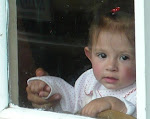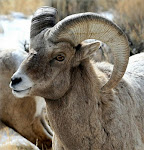The human face is magical. I used to sit for hours on Jackson square in New Orleans watching people. There was a never-ending procession of emotions, memories, needs and purposes, all wrapped up in their temporary little "earth suits". Their faces were the windows to the wonders inside.
If you delight and are fascinated in the human face as an art form or a heart warm visit Ken Flett's Shaping Stones. His magical blog will take you along with him on his pauper's tour of Canada. The loss of innocence, the shadows of reality, the joy of hopes and dreams, the toothless grins and weathered faces will have you mesmerized.


Subject One


I am not a portrait painter yet. I hope to be one someday. I would like to show you 2 of the stages before the finished pieces that I posted On Part 1 of this multi-blog.
Subject 2
These are on 5 x 7 wood panels using acrylics. It was hot, dry and windy when I did these, making acrylics very difficult to use. I had to keep my spray bottle going frequently. Acrylics, I find, are difficult to use for blending. I may switch to oils for portraits, because of the subtle changes in the tonal values of the face.
The first stage is just getting the image on the surface and blocking in the basic colors. On the first stage I have 5 or 6 layers of paint. To get the initial image on to the suface in the proper proportions I fudge. These are 5 x 7's which are the dimensions of an image when you print out 2 to the page. I simply use graphite paper and trace the basic outlines with a old pen or a nail. Then start blocking in the colors.
On stage two, I step back and see if I have everything fairly well in place. If not, I try to fix it. I have always had a big problem. My left eye is lower than my right, and, if I work close up, without stepping back to take a look, my image has a drastic slope to the upper right like it was being sucked into a vacuum cleaner. There is a vestige of this in Subject 2. At this point, I lay in the tonal values and try to start approximating colors. Human skin has 15 million shades at least. From there I work the details till I'm fairly satisfied.
On detailing, I really have to ease off the pedal. Working with detail brushes, spotters and liners, I gotta try a little tenderness. If I can discern that the brush is touching the surface, I'm probably painting too hard. A technique I use to some success on my wildlife...beetles, frogs, butterflies, etc. is to do what I call "pixelling". Applying teensy tiny pinpoints of a darker color to achieve variations in value. Works in comic books.
I wanted to mention another thing about transferring and image to the surface you're gonna work on. When my friend, Jim, saw me tracing/transferring an image to a blank 8 x 10 canvas, he asked me if that wasn't "cheating"...weren't artists just supposed to draw it on? I asked him why he didn't use a screwdriver to drive a nail. "Cause a hammer works better" he replied. You use whatever tools necessary to make the task easier, and do a better job. In painting, the work begins after the image is transferred. For larger pieces, I use a grid. I used to do a lot of sign painting ...including Oil Storage tanks and sides of buildings.
For medium works, I use an opaque projector, but don't have one currently.
So that's that. I'm about the last person in the world to give anybody a lesson in painting, so don't consider this one. I'm just sharing with you how I do it. If anyone has any comments or suggestions on how to work easier or improve my quality, I'm all ears. That's what we're here for.
Everett Raymond Kinstler
The first stage is just getting the image on the surface and blocking in the basic colors. On the first stage I have 5 or 6 layers of paint. To get the initial image on to the suface in the proper proportions I fudge. These are 5 x 7's which are the dimensions of an image when you print out 2 to the page. I simply use graphite paper and trace the basic outlines with a old pen or a nail. Then start blocking in the colors.
On stage two, I step back and see if I have everything fairly well in place. If not, I try to fix it. I have always had a big problem. My left eye is lower than my right, and, if I work close up, without stepping back to take a look, my image has a drastic slope to the upper right like it was being sucked into a vacuum cleaner. There is a vestige of this in Subject 2. At this point, I lay in the tonal values and try to start approximating colors. Human skin has 15 million shades at least. From there I work the details till I'm fairly satisfied.
On detailing, I really have to ease off the pedal. Working with detail brushes, spotters and liners, I gotta try a little tenderness. If I can discern that the brush is touching the surface, I'm probably painting too hard. A technique I use to some success on my wildlife...beetles, frogs, butterflies, etc. is to do what I call "pixelling". Applying teensy tiny pinpoints of a darker color to achieve variations in value. Works in comic books.
I wanted to mention another thing about transferring and image to the surface you're gonna work on. When my friend, Jim, saw me tracing/transferring an image to a blank 8 x 10 canvas, he asked me if that wasn't "cheating"...weren't artists just supposed to draw it on? I asked him why he didn't use a screwdriver to drive a nail. "Cause a hammer works better" he replied. You use whatever tools necessary to make the task easier, and do a better job. In painting, the work begins after the image is transferred. For larger pieces, I use a grid. I used to do a lot of sign painting ...including Oil Storage tanks and sides of buildings.
For medium works, I use an opaque projector, but don't have one currently.
So that's that. I'm about the last person in the world to give anybody a lesson in painting, so don't consider this one. I'm just sharing with you how I do it. If anyone has any comments or suggestions on how to work easier or improve my quality, I'm all ears. That's what we're here for.
Everett Raymond Kinstler
When it comes to portraits, my artists are Nelson Shank, John Singer Sargent and Everett Raymond Kinstler. But even great artists are human. And I have presented two portraits by Kinstler below that I have ripped off an old copy of American Artist. I hope I don't get ripped up for featuring them. STOP RIGHT NOW AND STUDY THEM BEFORE YOU READ ANY FURTHER. Did you see anything not kosher? If you look at the seated gentleman holding the cigarette, that cigarette hand is extending downward like a watch out of "Persistence of Memory" . And in Katherine Hepburn's portrait (which is exquisite because of it's striking resemblance with a minimum of detail), if she were to stand up, her right arm would touch the ground. I think I'm right in my perception, but if you disagree let me know. Particularly in the gentleman's portrait, the anatomically incorrect hand totally distracts from the otherwise marvelous piece. It's as if Michelle Obama walked into a Presidential Gala wearing a stunning Creation by Dior, but her slip is showing about 10 inches. Everybody would notice the slip.
This goes back to what I was saying about standing back and taking a good look to see if you're going in the right direction. You have to make the journey out and in. The same principle applies in our everyday lives, but I'll save that for a philosophy blog.

This goes back to what I was saying about standing back and taking a good look to see if you're going in the right direction. You have to make the journey out and in. The same principle applies in our everyday lives, but I'll save that for a philosophy blog.

E



.jpg)
.jpg)































From what I've witnessed so far, I think you're doing wonderfully with the portrait painting process, James. John Singer Sargent is one of my favorites as well, and Ken Flett is a great guy:)You've got good taste.
ReplyDeleteYour an active volcano James, spewing out humor and wise words, poetic and warm, your open arms are welcoming. Thank you.
ReplyDeleteps...thanks Nancy :)